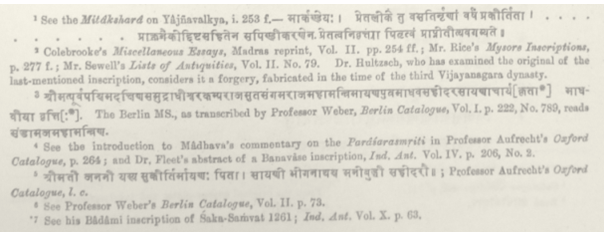|
The Indian Analyst
|
North Indian Inscriptions |
BITRAGUNTA GRANT OF SAMGAMA II. completion of all obsequial rites ; and this completion is reached with the sâpiṇḍya and âbdika ceremonies, which are to be observed at the end of one full year after the death. After this period, and through the several charities made during the final ceremonies, the Prêta is supposed to become one of the Manes, i.e. to become classed with the Pitṛidêvas.1 Thus, it may be that the anniversary on which immortality or godhead was conferred on Kampa, was the first ; and if so, the date of Kampa’s death and the accession of Saṁgama II. would be Śaka-Saṁvat 1277. But this is only a conjecture which requires corroboration. ......The contents of the inscription furnish us with two important facts, viz. first, the distinct
mention of the five sons of Saṁgama I., and, secondly, that of a grandson of his, by name
Saṁgama II. Both these facts are valuable ; for, most of the inscriptions that contain a
regular genealogy of the Vijayanagara dynasty, mention only Harihara I. and Bukka I.,
the first and third sons of Saṁgama I., and ignore altogether the other three ; and even the
limited few that mention all the five sons of Saṁgama I.,2 are either open to suspicion or are
imperfectly read. The importance of the second fact is even greater, inasmuch as it enables us
to correct certain inferences which have been drawn from the colophon of the Mâdhavîyâ Dhâtuvṛitti. This colophon reads as follows :— “The Mâdhavîyâ Vṛitti, composed by
Sâyaṇâchârya (who was) the uterine brother of Mâdhava, the son Mâyaṇa, (and) the great
minister of Saṁgamarâja, the son of Kamparâja, the glorious lord of the Eastern,
| ||||||||||||||||||||||||||||||||||||||||||||||||||||||||||||||||||||||||||||
| > |
|
>
|








